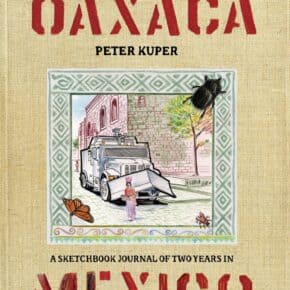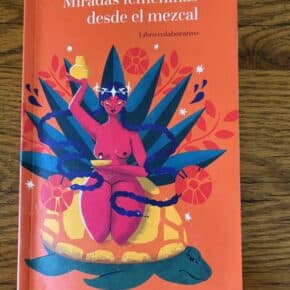This beautifully illustrated book, part Oaxaca travelogue, part sketch book, part historical action report of the teachers strikes in Oaxaca, and a more general meditation on Mexico is a stream of consciousness perspective of the two years that Peter Kuper spent on sabbatical there from 2006 – 2008. He went to escape the Bush years and ended up in the white hot cauldron of Mexican politics. That provides the pretext and much of the narrative thrust because he was a firsthand witness to the struggle between teachers and the new political powers.
You probably already know Kuper from his distinctive illustrations of stressed out people that have graced the covers of many magazines and newspapers over the years. He did Spy vs Spy for Mad Magazine but since then has evolved on parallel paths of graphic novelist and spot illustrator. He has a particular penchant for creating illustrated versions of classic novels, his latest is Heart of Darkness.
Diario de Oaxaca, Mexico foregrounds Kuper as reporter. In the preface he says that “I didn’t look at take on the job of Oaxaca reporter, but i had firsthand information about this subject and rediscovered that applying my art this way was part of my DNA as a political cartoonist.” The illustrations from the protests are all there in vivid color – it really is shocking to be reminded of that period because it doesn’t feel like present day Oaxaca.
But the book is so much broader than that. It’s a kaleidoscopic presentation of the scenes, the street art, the street life, wandering through Oaxaca and its politics. It really is a sketch book full of illustrated doodles and a narrative that touches all the amazing lacunae of Oaxaca. The masks, the bugs (Kuper indulges in a life long fascination with them), the colors, the dogs, the plants (even if there is nary an agave!), and the people. Kuper has an amazing eye for the Felliniesque face and the scenes that we all stop to witness and quickly forget like his silent account of a couple’s fight on the beach drawn while he was vacationing in Puerto Escondido.
It’s also a return to a different era that predates the Mezcal Rush. Even though tourism was big when Kuper was in Oaxaca, it’s become something entirely different since with an explosion of restaurants, rooftop bars, and mezcalerías. Back when he was living there, all the mezcalerías that define the city today didn’t even exist. Mezcal had yet to truly announce its presence as a reason to travel to Oaxaca and merits barely two mentions in this entire book. It’s a great reminder of the transformation and what hasn’t changed politically or structurally about the place.
It’s even more striking when compared with the Oaxaca of today. Whereas just a few years ago Trique protesters remained camped out under grungy tarps on the Zocalo, today it’s a different scene. The Zocalo is empty of tents, tourists stroll, bands play in cafes under the porticos. If you wander a few blocks off the square, there are still tents pitched by teachers. They’re just placed a discrete distance away from the center of tourism. I don’t have any insight into what sort of compromise put them there, but they still stand and prompt questions from passerby. Other aspects of Oaxaca’s protest culture remain active and in-your-face: Bloqueos, while not always teacher driven, remain constant and we were fortunate to run into only one bloqueo and doubly fortunate that we were able to quickly detour around it.
Kuper hasn’t stopped returning to Oaxaca. The most recent edition of Diario de Oaxaca, Mexico has a post script from 2017 which contains a pointer to his graphic novel Ruins which is something of a fictional riff on the trip he illustrates here. Judging from his Instagram feed, he was in Oaxaca just last week – I take that as a sign that his connection to the place only endures.
If you’re ever in need of other book recommendations, check out our Bookshop page.













Leave a Comment